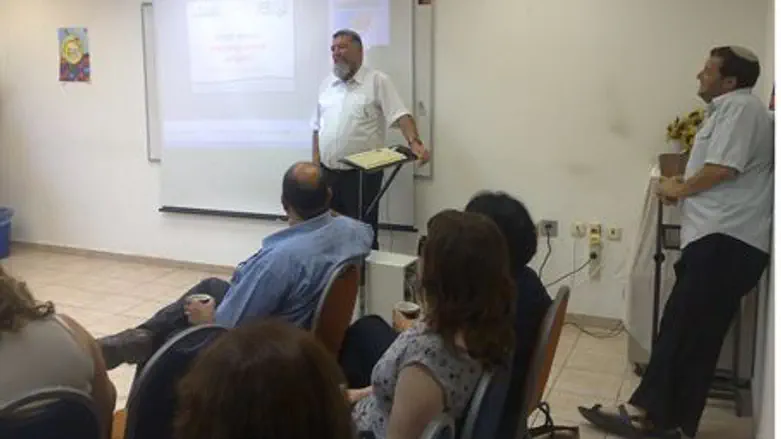
Dozens of journalists from the Jerusalem Journalists’ Association toured Judea and Samaria on Tuesday.
The tour took place as part of an outreach program aimed at making Israeli and international journalists, politicians and other opinion-shapers, many of whom are politically left-wing, less hostile to Jewish communities in Judea and Samaria.
For most of the journalists who took part in Tuesday’s tour it was the first time they were beyond the ‘Green Line,’ and all were impressed and excited about their visit to an area which they did not previously know.
Following the tour, Journalist Tzipi Roman, who chairs the Association of Journalists’ Culture Committee, published an article on the Association’s website in which she addressed the internal debate on whether to hold the tour, spoke of the tour itself, and mentioned the conclusions she reached in its wake.
Arutz Sheva brings you an English translation of Roman’s article:
An intelligent person at the Shomron Regional Council decided that the smartest thing he could do is not to use words when speaking to the residents of the ‘right’ side of the Green Line, but rather to have those individuals who mold public opinion come to the place itself, see the action and meet the people who live there.
Thus, members of the Jerusalem Journalists’ Association were invited for a one-day tour in areas about which one usually hears and reads in the media following events, conflicts, or – an example from the headlines these days - the boycott law.
Truth to tell, within the Association’s welfare-cultural committee, to which the invitation to the tour was brought, there were differing opinions about whether to accept an invitation with a political hue. Ultimately, it was decided to accept the offer and a message about it was posted on the Association’s website for the attention of its members.
Soon enough the phone on the desk of Secretary General Tzipi Yonah began to ring. Journalists, as it turns out, are curious, interested, and self-reliant people, who are confident that a one-day tour will not change their political views, and that if it does, they’ll handle it.
So we went out, 32 people led by Boaz Haetzni, on a tour aboard an armored bus (which weighs 21 tons because of the armoring, and that is without the human cargo on it)....
“The biggest enemy of the settlement is ignorance. More than 90% of the citizens of Israel have never been to Samaria,” Gershon Mesika, head of the Samaria Regional Council, told us. “The purpose of the tour is not to change your mind but to get you to know the area.”
Mesika’s aide, Yossi Dagan, provided us with some data: The Samaria Region (the northern part of Judea and Samaria) covers 12% of Israel’s western portion, and includes within it parts of areas A (which is under Arab control and includes Arab citizens), B (which is under Israeli security control and includes Arab citizens), and C (which is under Israeli control and includes Israeli citizens, and makes up about 60% of the land).
In all of the Samaria Region there are about 80,000 people (of which 13,000 are students in the Ariel University Center), and a number of local authorities operate within it, the Samaria Regional Council being one of them. Its area is 2,800sq km and it includes 35,000 people living in 30 communities - 55% of them secular and 45% of them religious. The distance between Tel Aviv and Jordan via the Trans-Samaria Road is 70 km, 55 km of which go through Samaria.
The program was full and gave the group, in a nutshell, a sense of what it is like living in the region.
The Barkan industrial area (a 13-minute drive from Kesem Junction), for example, has 120 factories which employ 6,000 workers, half of which are Jews and half of which Arabs. These, among others, are the factories at which the boycotters point arrows...
Among other places, we visited the community of Nofim, we toured Ariel, we had an organic lunch at the Givot Olam Farm (which sits on a ridge that begins in the community of Itamar), and we heard the story of Avri Ran, a former pilot from a kibbutz who became religious, came to Samaria 15 years ago and established a ‘point’ to which other people eventually came, including teenagers in distress who rebuilt their lives there.
When the ‘point’ became an agricultural community which stood on its own, Ran and his family moved to another ‘point’, followed by another one, and now Ran heads the Givot Olam Farm, which grows all its products by itself and is the largest organic egg farm in Israel.
In Elon Moreh - the most remote community of all the communities in the area – we met with Benny Katzover, one of the founders of the community which has 400 families, who for 13 years stood at the head of Samaria Regional Council and today heads the Samaria Residents Council.
We heard a historical-biblical outline, we went up to Har Kabir to watch the surrounding area (from atop the Mitzpeh Shloshet Hayamim, on a day where there is good visibility, you can see the Kinneret, the Dead Sea and the Mediterranean Sea), and heard the fascinating story of Joshua’s Altar which was exposed by Prof. Adam Zertal of Haifa University on Mount Eval.
We visited the Samaritan Museum on Mount Gerizim and met with the Cohen Yefet Ben Asher, who told us about the community which numbers about 750 people, half of whom live in Holon and the other half, who lived for generations in Shechem, now living in the Samaritan neighborhood on Mount Gerizim.
We concluded the tour by visiting the Tura Winery in Rehelim with Vered Ben-Saadon who, along with her husband Erez planted vineyards and produces award-winning wine. Equipped with bottles of wine and olive oil purchased in the winery, the visitors boarded the Samaria Regional Council bus on their way home. After three quarters of an hour we were back home in Jerusalem. Samaria and its residents, we discovered, are not beyond the Dark Mountains."
